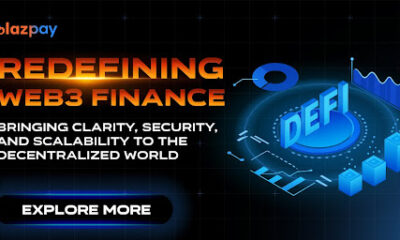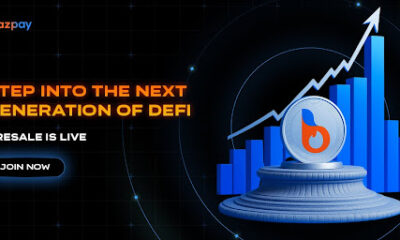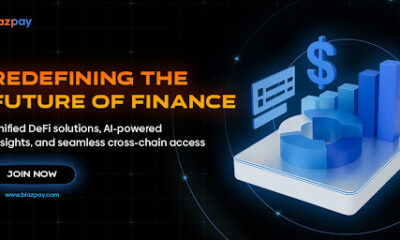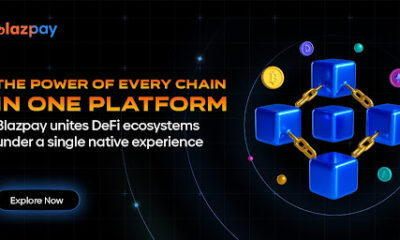Blockchain
$373M Raised & Counting: Here’s How BlockDAG’s Buyer Battles Are Turning Its Presale into a Daily Crypto Showdown

Most crypto presales are slow burns, focused on raising funds and building a following. BlockDAG has changed that playbook entirely. Its Buyer Battles feature transforms buying into a daily competition, keeping participants glued to the action. With more than $373 million already secured in Batch 29 at $0.0276, the funding is in place, but this gamified twist is keeping the excitement alive all the way to launch.
This isn’t just about acquiring BDAG coins; it’s about sparking urgency, encouraging participation, and rewarding those who commit. As BlockDAG inches closer to its confirmed exchange debuts, Buyer Battles is emerging as one of the most attention-grabbing and strategically effective elements of its presale.
Buyer Battles: Injecting Competition into the Presale
Buyer Battles takes a simple concept, rewarding purchases, and builds a structured contest around it. Each day, a fixed amount of BDAG is available for purchase. If any remains unsold when the 24-hour clock runs out, it’s awarded to the day’s top buyer for free.
This has two clear effects. First, it pushes bigger buyers to aim for the top spot for a shot at extra BDAG without paying more. Second, it drives constant engagement, with participants checking leaderboards and making calculated moves as the day unfolds.
A daily reset at midnight ensures no one dominates the top position for long. Every 24 hours, new players and returning participants start fresh, making it a fair fight. Even smaller buyers may decide to increase their bid if they see the top spot is within reach.
By turning the presale into an interactive contest, BlockDAG avoids the usual lull between early hype and launch. Instead, interest builds steadily, with each day offering a new chance to win.
Presale Power: $373M Raised in Batch 29 at $0.0276
Buyer Battles works because it’s layered on top of a blockbuster presale. With more than $373 million raised, BlockDAG ranks among the biggest ongoing token sales of 2025. In Batch 29, BDAG is priced at $0.0276, leaving a shrinking entry window before the price climbs in the next batches.
The success reflects the strong response to BlockDAG’s larger vision and its inventive presale mechanics. High funding ensures the team can accelerate development, lock in partnerships, and prepare for a smooth launch.
What makes Buyer Battles even more effective is how it adds urgency on top of batch price progression. Buyers already know the price will rise with each new batch, and now they have a reason to act every single day for bonus allocations. This combination of hourly and daily incentives keeps the presale in constant motion.
With liquidity and an active community already forming, BlockDAG is setting the stage for a strong transition to live trading.
Exchange Listings: Liquidity on Day One
The competitive buzz of Buyer Battles carries over after launch. BlockDAG has confirmed listings with 20 exchanges, including MEXC, BitMart, LBank, Coinstore, and XT.com. This multi-exchange rollout ensures BDAG will be accessible to a global audience immediately, minimizing the early liquidity problems that can plague new listings.
For Buyer Battles participants, this means the tokens they earn aren’t just sitting idle. They’ll be tradable on multiple platforms from day one, giving immediate market value to the extra BDAG won during the presale.
By connecting the excitement of the presale with guaranteed exchange access, BlockDAG makes participating now even more appealing. The $0.0276 price point and daily bonus chances create a narrow but enticing window for those who want to enter before the next phase.
Closing Thoughts
BlockDAG’s Buyer Battles have taken the traditional presale model and turned it into a high-engagement, competitive event. With $373 million already secured in Batch 29 at $0.0276 and 20 confirmed exchange listings, participants know their rewards will soon be liquid and trade-ready.
The structure delivers daily engagement, fair competition, and tangible incentives, all while building toward a launch backed by strong funding and community support. For those seeking a presale that offers more than a static purchase, BlockDAG’s approach blends the thrill of competition with the reassurance of a well-prepared project.
Presale: https://purchase.blockdag.network
Website: https://blockdag.network
Telegram: https://t.me/blockDAGnetworkOfficial
Discord: https://discord.gg/Q7BxghMVyu
Blockchain
Bitcoin and BNB Analysis: Blazpay Phase 5 Launches as Investors Hunt for the Top Crypto Coins to Buy
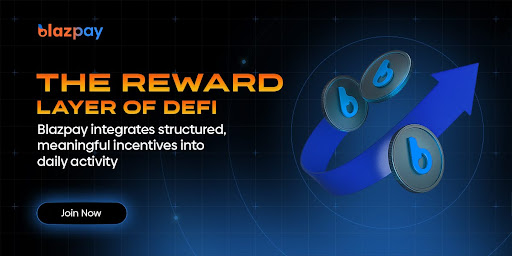
The crypto market continues to evolve with investors seeking high-potential tokens and utility-driven platforms. Among the best presale crypto opportunities, Blazpay stands out in Phase 5, attracting attention as one of the most promising AI crypto coins. Alongside established cryptocurrencies like Bitcoin and BNB, the presale offers an early entry point with asymmetric upside potential, making it a key focus for anyone evaluating the next crypto coins to buy
Blazpay Presale Phase 5 – The Smart Move for Crypto Investors
Blazpay has officially started Phase 5, with the price currently set at $0.0135 and scheduled to increase to $0.0135 after this phase closes. So far, 236M of the 249.04M BLAZ tokens have been sold, with $2.04M already raised. With AI-enhanced utilities, multichain support, and gamified services, Blazpay positions itself as a leading presale token among the best crypto presale platform options today.

Gamified Rewards and Perpetual Trading Benefits
Blazpay’s ecosystem combines gamified engagement with perpetual trading options. Investors are incentivized to complete milestones, participate in AI-driven tasks, and maintain long-term activity within the platform. The integrated AI provides automated trading suggestions, while multichain connectivity ensures fast, low-fee transactions across networks, making Blazpay a unique AI crypto coin presale with tangible utility.
Blazpay Referral Program – Rewarding Early Advocates
The Blazpay referral system allows investors to earn rewards whenever their referrals participate in the presale. This creates a compounding incentive for early adopters to expand their network and increase their token allocation, especially valuable during Phase 5, where the price is set to rise shortly.
Blazpay Price Prediction – Growth Potential in 2025
Industry analysts suggest that Blazpay’s Phase 5 presale positions the token for potential substantial gains post-launch. With AI-driven utilities, gamified rewards, and growing investor demand, projections suggest Blazpay could achieve significant milestones relative to established cryptocurrencies. Early-phase investors are particularly well-positioned to capitalize on future price movements.
Blazpay $2,000 Strategy – Early Entry Advantage
A $2,000 purchase during Phase 5 at $0.0135 secures roughly 170,213 BLAZ tokens. If the token reaches $0.05, the position grows to $8,511. At $0.10, it rises to $17,021. Should Blazpay hit $0.25, the investment could be worth $42,553. This demonstrates the asymmetric upside for early participants, making Phase 5 a key entry window.
How to Buy BLAZ
To participate before the Phase 4 supply sells out:
- Visit the official Blazpay presale page
- Connect your wallet (MetaMask, Trust Wallet, Coinbase Wallet)
- Select your preferred currency (ETH, BNB, USDT, SOL)
- Enter the amount you want to purchase
- Confirm the transaction and claim tokens after launch
Bitcoin (BTC) – Leading Crypto Coin to Buy for Institutional Exposure
Bitcoin (BTC) is trading at approximately $87,822 USD as of December 17, 2025, up 1.63% from the previous day. The digital asset continues to dominate the market, offering investors exposure to a proven store of value and hedge against inflation. Despite being 17% below last year’s highs, BTC shows strong institutional interest, with long-term holder supply at an 8-month low of 14.34 million BTC. With potential ETF inflows and ongoing adoption, Bitcoin remains one of the top crypto coins to buy for those seeking stability with growth potential in the digital asset space.
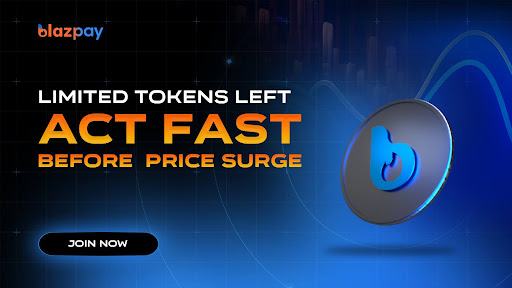
BNB – Established Blockchain Token Among Top Crypto Coins to Buy
BNB is holding steady around $857 USD, supported by $2.6 billion in 24-hour trading volume. The BNB Chain ecosystem continues expanding with initiatives like a new stablecoin targeting institutional usage, strengthening its utility in decentralized finance and trading platforms. While short-term fluctuations occur, BNB’s consistent network adoption and high liquidity make it a strong candidate among crypto coins to buy for investors looking to combine platform utility with long-term potential.
Conclusion
Blazpay’s Phase 5 presale offers investors the chance to access one of the most promising AI crypto coins early, with multichain utility and gamified rewards driving strong adoption. Complementing BTC’s store-of-value role and BNB’s utility-focused growth, this trio represents a strategic combination of new and established crypto assets. For investors seeking asymmetric potential alongside reliable blockchain leaders, Blazpay, Bitcoin, and BNB remain top crypto coins to buy in 2025.
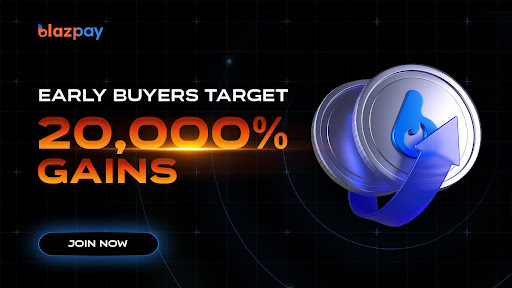
Join the Blazpay Community
Website: www.blazpay.com
Twitter: @blazpaylabs
Telegram: t.me/blazpay
FAQs
Q1. What makes Blazpay stand out among new crypto coins?
Its AI-enhanced automation, gamified services, and cross-chain capabilities differentiate it from traditional presale tokens.
Q2. How can I participate in Blazpay Phase 5?
Investors can buy BLAZ tokens via the official presale platform using the integrated steps for wallet connection and token purchase.
Q3. Why include Bitcoin and BNB in a presale portfolio?
BTC offers long-term stability, while BNB provides utility exposure in a major ecosystem, complementing early-stage tokens like Blazpay.
Q4. What is the risk/reward profile of Blazpay?
High potential upside due to Phase 5 presale pricing and AI-powered utility, balanced against typical early-stage crypto volatility.
Q5. How long until the next Blazpay price increase?
Phase 5 has just started, and the price will rise from $0.0135 to $0.0155 after completion.
Blockchain
DinoSol Debuts as a Meme-Driven Solana Token With Community-First Positioning

DinoSol (DINOSOL), a new entrant in the Solana meme-coin ecosystem, has launched with a strong emphasis on branding, simplicity, and early-stage community engagement. Built on Solana and centered around a playful, cartoon-styled dinosaur mascot, DinoSol joins the growing wave of culture-driven memecoins that leverage viral identity over utility-heavy roadmaps.
While still in its early development phase, DinoSol positions itself as a community-focused token aiming to expand through social momentum, low-cost Solana transactions, and a recognizable visual identity.
A Meme Coin Built on Solana’s High-Speed Infrastructure
DinoSol operates on the Solana blockchain, benefitting from fast, inexpensive transactions — a critical advantage for meme coin communities that thrive on rapid micro-trading, gifting, and community campaigns.
The project highlights accessibility as a core pillar: lightweight token mechanics, easy integration with Solana wallets, and a low barrier to entry for new users entering the meme token space.
Branding, Lore, and Community Identity
Unlike utility-first projects, DinoSol leans heavily on meme culture and its distinctive mascot. The design reflects exaggerated cartoon expressions, bright color themes, and a comedic aesthetic intended to resonate with viral crypto culture.
The branding suggests a lighthearted, entertainment-driven narrative — a key trait of recent memecoin successes.
DinoSol emphasizes community participation across its homepage and social channels, positioning the token as a collective movement rather than a structured technical product.
Tokenomics and Supply
Based on available public details, the token operates with a fixed supply model, a common approach in Solana meme tokens designed to reinforce scarcity and encourage early participation.
No complex staking, lockups, or reward mechanisms are described — aligning with its simplified meme-first positioning.
The focus remains on transparent supply, easy ownership, and frictionless trading.
Emerging Market Presence
As a newly listed asset on CoinMarketCap, DinoSol joins the expanding roster of Solana-based memecoins that have gained traction throughout 2025. While early trading metrics are still forming, interest has grown due to:
- Rapid community expansion
- Strong memeable branding
- Increasing visibility across Solana meme-fi culture
DINOSOL’s growth trajectory will depend largely on social momentum and how quickly the project can sustain community engagement.
Outlook
DinoSol is entering a highly active segment of the crypto market, where cultural resonance and simplicity often outweigh utility at launch. If meme sentiment on Solana continues to strengthen, DinoSol could benefit from the broader trend toward culture-and-community driven tokens.
For now, the project remains early-stage but well-positioned within Solana’s thriving meme ecosystem.
Blockchain
Blazpay AI Crypto Presale Announces Verified Audit as Phase 5 Surpasses $2.02M
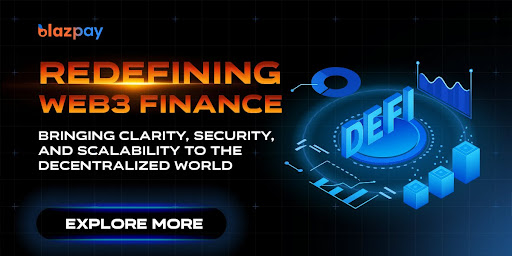
The Blazpay AI crypto presale continues to accelerate at an exceptional pace, crossing $2.02 million raised with 237.41 million BLAZ tokens sold out of 260.04 million in Phase 5 and reaching 91.3% completion. With the automatic price increase from $0.0135 approaching rapidly, Blazpay has now confirmed the successful completion of a full smart contract audit. This development amplifies investor confidence and positions Blazpay as one of the most secure, transparent, and high-potential projects in the AI crypto presale sector.
As the countdown to the Phase 5 price jump continues, audit verification has become the strongest catalyst driving new investors toward Blazpay, reinforcing its reputation as one of the best presale crypto opportunities and a clear top crypto to invest in for the upcoming AI-driven market cycle.
Audit Verification Brings Maximum Trust to the Blazpay Ecosystem
Blazpay’s verified audit confirms that its smart contracts, token mechanics, and operational frameworks meet the highest security standards. The audit report highlights that the system is free from critical vulnerabilities, and its AI orchestration layers meet strict transparency requirements. This level of validation is rare among early-stage blockchain projects and gives Blazpay a competitive advantage as the best crypto presale platform for investors seeking reliability alongside innovation.
The audit process examined the entire ecosystem, including the multi-chain settlement modules, the transactional infrastructure, and every segment of automated AI execution. The results confirm stability, efficiency, and immutability across the protocol, allowing investors to enter the AI crypto presale with confidence that contract logic and investor funds remain fully protected.
In a market where trust determines survival, Blazpay’s successful audit places it far ahead of non-audited competitors and positions it as one of the top crypto to invest in during this phase of the AI-powered blockchain expansion.
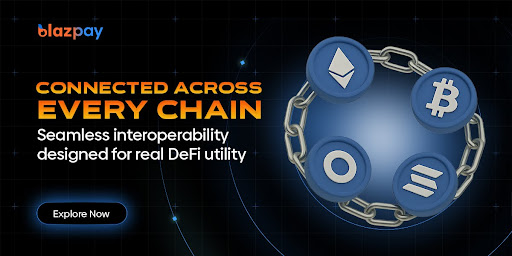
Why the Audit Strengthens Blazpay’s AI Utility Framework
Blazpay’s audit aligns directly with its expanding multi-utility AI ecosystem. The Conversational AI Execution engine enables users to interact with blockchain operations using natural language inputs, creating a frictionless AI-driven financial environment. The AI perpetual trading engine runs market analysis around the clock, delivering optimized trade execution without emotional interference. Blazpay’s multichain settlement network ensures smooth cross-chain movement of assets between Ethereum, BNB Chain, Polygon, and additional supported chains without depending on external bridges.
Developers have access to the Blazpay AI SDK, enabling the creation of AI-powered dApps, automation bots, and advanced infrastructure tools. The ecosystem also includes gamified AI rewards, encouraging user participation and continuous engagement.
These combined utilities gain significant credibility now that every operational module has been reviewed and verified by the audit, further elevating Blazpay as a leading AI crypto presale entering 2025.
Blazpay Price Forecast After Audit Verification
Analysts predict that the audit will strengthen Blazpay’s projected launch performance. The expected listing range for early 2025 sits between $0.03 and $0.05, supported by increasing demand and the completion of its AI utilities. Mid-term forecasts suggest a rise toward $0.15 to $0.25 by 2026 as the ecosystem gains real-world usage across decentralized applications and AI financial automation.
In a full market expansion, where AI tokens historically perform exceptionally well, Blazpay holds potential to reach the $0.75 to $1.00 zone. The audit outcome reinforces this projection by reducing risk and increasing investor confidence, solidifying Blazpay’s place among the best presale crypto investments of the current cycle.
$1,500 Audit-Backed Blazpay Accumulation Strategy
At the Phase 5 presale price of $0.0135, a $1,500 investment in Blazpay would secure approximately 111,111 BLAZ tokens. With audit-backed security, early participation comes with added confidence for investors positioning ahead of future price moves.
If Blazpay lists at $0.05, this allocation would be worth roughly $5,555. A rise to $0.25 in 2026 would increase the position to about $27,778, while a full bull-cycle surge to $0.75–$1.00 could elevate the value to between $83,333 and $111,111. The verified audit and structured presale make Blazpay a compelling high-upside option for AI-focused crypto investors.

How to Participate in the Blazpay AI Crypto Presale
- Visit www.blazpay.com
- Connect MetaMask or WalletConnect
- Choose USDT, ETH, or BNB
- Enter the amount you want to invest
- Confirm the transaction
Final Call Before the Price Increase
With Phase 5 now 91.3% complete and the price preparing to rise, this is one of the final opportunities to enter the AI crypto presale at an early rate supported by full audit verification. The audit eliminates uncertainty while Blazpay’s ecosystem continues expanding across multichain utility, AI automation, and developer integration. This combination positions Blazpay as one of the best presale crypto projects and one of the strongest candidates for investors seeking the best crypto presale platform before the next market surge.

Join the Blazpay Community
Website: www.blazpay.com
Twitter: @blazpaylabs
Telegram: t.me/blazpay
About Blazpay
Blazpay is an audited AI-powered blockchain ecosystem combining Conversational AI execution, automated perpetual trading, multichain interoperability, developer SDK integration, and gamified rewards under a unified network. Its newly verified audit ensures maximum transparency and security, making the Blazpay AI crypto presale one of the most secure and promising opportunities of 2025. With Phase 5 nearing completion and community growth accelerating, Blazpay stands out as a top crypto to invest in and one of the best presale crypto launches of the upcoming AI cycle.
-

 Crypto3 years ago
Crypto3 years agoCardalonia Aiming To Become The Biggest Metaverse Project On Cardano
-

 Press Release5 years ago
Press Release5 years agoP2P2C BREAKTHROUGH CREATES A CONNECTION BETWEEN ETM TOKEN AND THE SUPER PROFITABLE MARKET
-
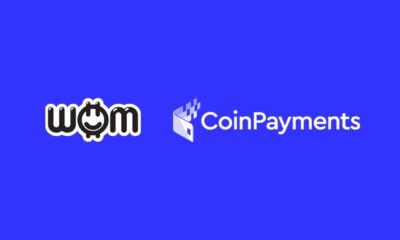
 Blockchain5 years ago
Blockchain5 years agoWOM Protocol partners with CoinPayments, the world’s largest cryptocurrency payments processor
-

 Press Release5 years ago
Press Release5 years agoETHERSMART DEVELOPER’S VISION MADE FINTECH COMPANY BECOME DUBAI’S TOP DIGITAL BANK
-
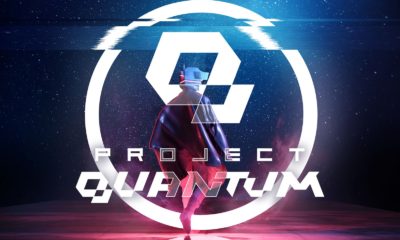
 Press Release5 years ago
Press Release5 years agoProject Quantum – Decentralised AAA Gaming
-

 Blockchain5 years ago
Blockchain5 years agoWOM Protocol Recommended by Premier Crypto Analyst as only full featured project for August
-

 Press Release5 years ago
Press Release5 years agoETHERSMART DEVELOPER’S VISION MADE FINTECH COMPANY BECOME DUBAI’S TOP DIGITAL BANK
-

 Blockchain6 years ago
Blockchain6 years ago1.5 Times More Bitcoin is purchased by Grayscale Than Daily Mined Coins

